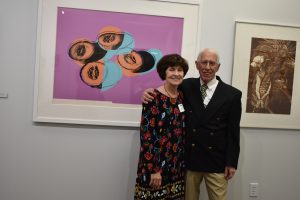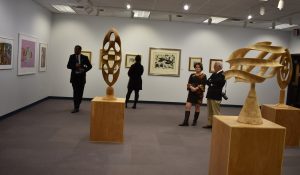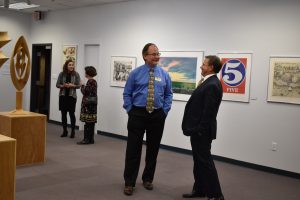 Dr. William Eickhorst, professor emeritus of art, was studying at Parsons School of Design in New York in the early 1960s when a friend in his printmaking class gave him one of his pieces. That print became the first acquisition in what was to become a collection of more than 1,000 prints. Last fall, nearly six decades later, Dr. Eickhorst and his wife, Edith, donated that collection to Missouri Western. It will be housed in a newly created gallery on the second floor of Spratt Hall.
Dr. William Eickhorst, professor emeritus of art, was studying at Parsons School of Design in New York in the early 1960s when a friend in his printmaking class gave him one of his pieces. That print became the first acquisition in what was to become a collection of more than 1,000 prints. Last fall, nearly six decades later, Dr. Eickhorst and his wife, Edith, donated that collection to Missouri Western. It will be housed in a newly created gallery on the second floor of Spratt Hall.
Amanda Morrow, University curator, said the collection includes a wide variety of work mostly from 20th and 21st century artists. It will be stored on campus and pieces will be rotated in the gallery on a regular basis. She and Eric Fuson, artist-in-residence, designed the gallery and storage space.
“We are so lucky to have the collection for the students and the community,” Morrow said. “It will be very educational.”
The collection also includes a small library of monographs of artists, printmaking history and printmaking technique that will be available to students.
 Dr. Eickhorst taught in the Department of Art at Missouri Western for 28 years, serving 15 years as department chair and teaching Art Theory and Criticism, The Business Aspects of Art, Art Education Methods, and Art Appreciation. He retired in 2006 and is an adjunct art instructor at Park University.
Dr. Eickhorst taught in the Department of Art at Missouri Western for 28 years, serving 15 years as department chair and teaching Art Theory and Criticism, The Business Aspects of Art, Art Education Methods, and Art Appreciation. He retired in 2006 and is an adjunct art instructor at Park University.
The entire collection was moved from Dr. Eickhorst’s home to campus this past spring, and Morrow and a student intern are busy inventorying and cataloguing the collection, which involves gathering and recording information about each print.
“The collection is stellar,” Morrow said. “It is so exciting to have access to it.”
About 20 years after Dr. Eickhorst acquired his first print, he formed a print consortium of printmaking artists across the country with the goals of advocating for printmakers and getting more prints viewed in exhibits. Cost to join the consortium? One print.
Over the next 25 years, Dr. Eickhorst took the prints he acquired through the consortium, matted and framed them, organized them and arranged the works to be exhibited at museums and universities, usually with 30-35 artists in each. At its peak, the consortium contained about 300 members from the United States and nine foreign countries.
“The consortium was doing something positive for artists and printmaking as an endeavor,” he said. “We were getting prints by artists exhibited and seen.”
For many of those years, the consortium generated a profit from renting out the exhibits, and those  funds were used to purchase prints at auctions. That was how Dr. Eickhorst acquired prints from Pierre-Auguste Renoir, Henri Matisse and Paul Cézanne, among others, for his collection.
funds were used to purchase prints at auctions. That was how Dr. Eickhorst acquired prints from Pierre-Auguste Renoir, Henri Matisse and Paul Cézanne, among others, for his collection.
“I’m always asked, ‘What’s my favorite?’ That’s like asking you which of your children is your favorite,” Dr. Eickhorst said. “I love them all for different reasons.”
A native of Hackensack, New Jersey and a U.S. Army veteran, Dr. Eickhorst graduated from Parsons with a degree in graphic design and earned bachelor’s and master’s degrees in art education from Montclair State University in New Jersey. At the time he graduated with his master’s degree, he held the distinction of being the only student in the history of the Art Department to both write a master’s thesis and have a thesis exhibition. He earned his doctorate in art education from Ball State University in Indiana.
That was where he met Edith. They have been married 47 years and have two children.
Throughout his career, he had 15 solo exhibitions, work included in six international juried exhibitions, 61 national and regional juried exhibitions and over 100 group shows.
Dr. Eickhorst said he had four goals when he thought about gifting his collection: 1) keep it intact, don’t split it up; 2) keep it in the Kansas City/St. Joseph area; 3) exhibit the prints; and 4) make it available to printmakers and scholars for study.
“Missouri Western matched perfectly with all four goals, as well as demonstrating a strong commitment to the fine and performing arts and a desire to make the arts more readily available to the community,” he said. “I think I made a wise choice!”
